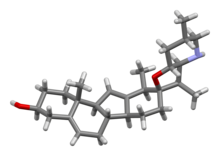 | |
 | |
| Names | |
|---|---|
| IUPAC name 17,23β-Epoxyveratraman-3β-ol | |
| Systematic IUPAC name (2′R,3S,3′R,3′aS,6′S,6aS,6bS,7′aR,11aS,11bR)-3′,6′,10,11b-Tetramethyl-1,2,3,3′a,4,4′,5′,6,6′,6a,6b,7,7′,7′a,8,11,11a,11b-octadecahydro-3′H-spirofluorene-9,2′-furopyridin]-3-ol | |
| Other names
• 11-Deoxojervine • (3β,23R)-17,23-Epoxyveratraman-3-ol | |
| Identifiers | |
| CAS Number | |
| 3D model (JSmol) | |
| ChEMBL | |
| ChemSpider | |
| ECHA InfoCard | 100.156.363 |
| PubChem CID | |
| UNII | |
| CompTox Dashboard (EPA) | |
InChI
| |
SMILES
| |
| Properties | |
| Chemical formula | C27H41NO2 |
| Molar mass | 411.630 g·mol |
| Except where otherwise noted, data are given for materials in their standard state (at 25 °C , 100 kPa).
| |
Cyclopamine (11-deoxojervine) is a naturally occurring steroidal alkaloid. It is a teratogenic component of corn lily (Veratrum californicum), which when consumed during gestation has been demonstrated to induce birth defects, including the development of a single eye (cyclopia) in offspring. The molecule was named after this effect, which was originally observed by Idaho lamb farmers in 1957 after their herds gave birth to cycloptic lambs. It then took more than a decade to identify corn lily as the culprit. Later work suggested that differing rain patterns had changed grazing behaviours, which led to a greater quantity of corn lily to be ingested by pregnant sheep. Cyclopamine interrupts the sonic hedgehog signalling pathway, instrumental in early development, ultimately causing birth defects.
Discovery and naming
In 1957, Idaho sheep ranchers contacted the US Department of Agriculture (USDA) after their sheep gave birth to lambs with a fatal singular eye deformity. After collecting local flora and feeding them to mice, USDA scientists struggled to recreate the cyclopia. After a decade of trial and error, they came across wild corn lilies and advised the ranchers to avoid the corn lilies. Cyclopamine was discovered as one of three steroidal alkaloids isolated from Veratrum californicum and was named after its effects on sheep embryos. Four decades later, a team led by Professor Phillip Beachy linked the effect of cyclopamine to the sonic hedgehog gene. Cyclopia was induced through silencing the sonic hedgehog gene, suggesting Cyclopamine acted through a similar mechanism.

Source and structure
Cyclopamine consists of six rings, including a C-nor-D-homosteroid backbone linked to a octahydrofuropyridine system through a spirocentre. The molecule contains ten chiral centres, six of which at ring junctions.
The Veratrum species were found to contain five related families of alkaloid: (1) solanidine alkaloids, (2) verazine alkaloids, (3) veratramine alkaloids, (4) jervine alkaloids, and (5) the cevanine alkaloids, each of which with cholesterol as a common precursor.
In its proposed biosynthesis, cyclopamine has a solanidine precursor. This was determined through initial studies which isolated alkaloids from Veratrum californium, and introduced these to embryonic sheep.
Considering its formation in vivo, the treatment of cyclopamine with dilute hydrochloric acid (0.5%) at 38 °C leads to the formation of veratramine - conditions similar to those of gastric acid. Veratramine is highly toxic, acting through excitation of the central nervous system causing seizures – similarly to serotonin. The mechanism for the formation of veratramine from cyclopamine is proposed to take place through the cleavage of the spirocyclic carbon-oxygen bond in the THF ring, which through elimination leads to the formation of a double bond. Afforded by the strong driving force afforded by aromatisation, ultimately a benzene ring forms.
Later studies also demonstrated that jervine could be degraded to cyclopamine through a Wolff-Kishner reduction, which served as evidence for the structure of cyclopamine.

Mechanism
Cyclopamine impacts embryonic development by interrupting the sonic hedgehog (Shh) pathway.
In healthy development, the Shh gene codes for Shh proteins. These proteins have a high affinity for the surface membrane protein patched. Upon binding, Shh proteins inhibit patched. With the patch protein inhibited, another surface membrane protein smoothened may signal further cascades which impact development.
Cyclopamine has a high affinity for smoothened – and upon binding, inhibits the signal. Even though Shh may inhibit Patched, Smoothened cannot signal in the presence of cyclopamine and thus the pathway is interrupted.
Embryological
Cyclopamine causes the most advanced form of holoprosencephaly. Because it blocks Shh signaling, the embryonic brain no longer divides into lobes (becomes alobar). Thus, only one optical track develops, hence the cycloptic (singular) eye. Furthermore, this disease is fatal and presently has no cure.

One can imagine one half of the healthy brain not dividing, but instead growing out and resembling the alobar brain. This occurs in cases of cyclopamine poisoning. This malformation is always fatal, and it is worth noting that there are lesser cases of holoprosencephaly that are not always fatal. However, embryonic cyclopamine poisoning causes the most extreme and therefore fatal cases.
Medical potential
Cyclopamine is currently being investigated as a treatment agent in basal cell carcinoma, medulloblastoma and rhabdomyosarcoma (tumours commonly resulting from excessive Shh activity), glioblastoma, and as a treatment agent for multiple myeloma. Studies of epithelial cancers have demonstrated that tumour cells secrete Shh ligand to signal adjacent growth factors production by stromal cells which leads to angiogenesis, tumour cell proliferation, and tumour cell survival.
With this in mind, one can imagine cyclopamine as a way of attenuating cancer's mechanism. However, while cyclopamine has been demonstrated to inhibit tumor growth in mouse xenograft models, it never reached therapeutic potential as it caused many side effects including weight loss, dehydration, and death in mouse models.
Two functional analogs of cyclopamine have been approved by the FDA; vismodegib in 2012, and sonidegib in 2015. Vismodegib was the first Shh pathway drug approved for treating cancer.
Vismodegib was designed to account for hydrogen bonding with the Smoothened receptor and to overcome the solubility issues of cyclopamine (through inclusion of the chlorine atom). The hydrogen bonds form at two sites: as a donor at a tyrosine residue and as an acceptor at an arginine residue. Whilst the hydrogen bond accepting group is more impactful, having both makes for stronger binding.

See also
- Saridegib (also known as IPI-926), a semisynthetic analog of cyclopamine
- Vismodegib, an artificial Hh signaling inhibitor
- Sonidegib, an artificial Hh signaling inhibitor
- Steroidal alkaloid, the family of molecules cyclopamine belongs to
References
- Chen, James K. (2016). "I only have eye for ewe: the discovery of cyclopamine and development of Hedgehog pathway-targeting drugs". Natural Product Reports. 33 (5): 595–601. doi:10.1039/C5NP00153F. ISSN 0265-0568. PMC 4856577. PMID 26787175.
- ^ "The strange case of the cyclops sheep - Tien Nguyen". TED-Ed. Retrieved 2018-04-27.
- ^ Heretsch P, Tzagkaroulaki L, Giannis A (May 2010). "Cyclopamine and hedgehog signaling: chemistry, biology, medical perspectives". Angewandte Chemie. 49 (20): 3418–27. doi:10.1002/anie.200906967. PMID 20429080.
- ^ Keeler, Richard F. (May 1969). "Toxic and teratogenic alkaloids of western range plants". Journal of Agricultural and Food Chemistry. 17 (3): 473–482. doi:10.1021/jf60163a012. ISSN 0021-8561.
- "The Role of HCL In Gastric Function And Health | Clinical Education". 2011-01-20. Retrieved 2023-10-14.
- ^ Rimkus TK, Carpenter RL, Qasem S, Chan M, Lo HW (February 2016). "Targeting the Sonic Hedgehog Signaling Pathway: Review of Smoothened and GLI Inhibitors". Cancers. 8 (2): 22. doi:10.3390/cancers8020022. PMC 4773745. PMID 26891329.
- Hytham Nafady (2015-09-13). "Congenital brain malformations". Slideshare. Archived from the original on 2018-04-25. Retrieved 2018-05-09.
- Taipale J, Chen JK, Cooper MK, Wang B, Mann RK, Milenkovic L, Scott MP, Beachy PA (August 2000). "Effects of oncogenic mutations in Smoothened and Patched can be reversed by cyclopamine". Nature. 406 (6799): 1005–9. Bibcode:2000Natur.406.1005T. doi:10.1038/35023008. PMID 10984056. S2CID 4313790.
- ^ Dr. Sutherlin, Dan (2017). "Discovering Vismodegib in the Fight Against Skin Cancer: The First Approved Inhibitor of the Hedgehog Pathway" (PDF). American Chemical Society.
Further reading
- Alam MM, Sohoni S, Kalainayakan SP, Garrossian M, Zhang L (February 2016). "Cyclopamine tartrate, an inhibitor of Hedgehog signaling, strongly interferes with mitochondrial function and suppresses aerobic respiration in lung cancer cells". BMC Cancer. 16 (1): 150. doi:10.1186/s12885-016-2200-x. PMC 4766751. PMID 26911235.
- Cancer Drug Behind Cyclops Birth?, Wired News
- Bar EE, Chaudhry A, Lin A, Fan X, Schreck K, Matsui W, Piccirillo S, Vescovi AL, DiMeco F, Olivi A, Eberhart CG (October 2007). "Cyclopamine-mediated hedgehog pathway inhibition depletes stem-like cancer cells in glioblastoma". Stem Cells. 25 (10): 2524–33. doi:10.1634/stemcells.2007-0166. PMC 2610257. PMID 17628016.
- "Experimental Anti-cancer Drug Kills Brain Tumor Stem Cells". ScienceDaily (Press release). August 31, 2007.
- Tabs S, Avci O (2004). "Induction of the differentiation and apoptosis of tumor cells in vivo with efficiency and selectivity". European Journal of Dermatology. 14 (2): 96–102. PMID 15196999.
- Taş S, Avci O (2004). "Rapid clearance of psoriatic skin lesions induced by topical cyclopamine. A preliminary proof of concept study". Dermatology. 209 (2): 126–31. doi:10.1159/000079596. PMID 15316166. S2CID 28753644.
- Zhang J, Garrossian M, Gardner D, Garrossian A, Chang YT, Kim YK, Chang CW (February 2008). "Synthesis and anticancer activity studies of cyclopamine derivatives". Bioorganic & Medicinal Chemistry Letters. 18 (4): 1359–63. doi:10.1016/j.bmcl.2008.01.017. PMID 18221872.
- Fan Q, Gu D, He M, Liu H, Sheng T, Xie G, Li CX, Zhang X, Wainwright B, Garrossian A, Garrossian M, Gardner D, Xie J (July 2011). "Tumor shrinkage by cyclopamine tartrate through inhibiting hedgehog signaling". Chinese Journal of Cancer. 30 (7): 472–81. doi:10.5732/cjc.011.10157. PMC 4013422. PMID 21718593.